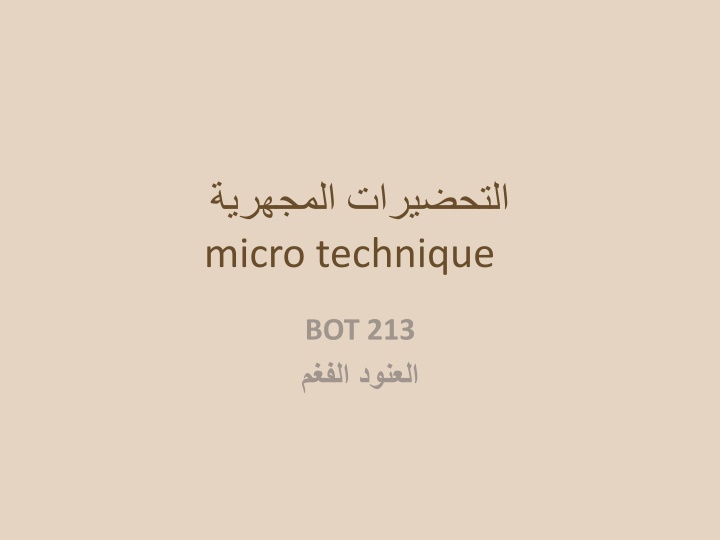
Laboratory Safety Rules and Equipment for Micro Technique
Learn about important laboratory safety rules such as wearing a laboratory coat, using safety equipment, and handling apparatus correctly in a micro-technique environment. Discover the proper care of microscopes and essential guidelines to ensure a safe laboratory environment.
Download Presentation

Please find below an Image/Link to download the presentation.
The content on the website is provided AS IS for your information and personal use only. It may not be sold, licensed, or shared on other websites without obtaining consent from the author. If you encounter any issues during the download, it is possible that the publisher has removed the file from their server.
You are allowed to download the files provided on this website for personal or commercial use, subject to the condition that they are used lawfully. All files are the property of their respective owners.
The content on the website is provided AS IS for your information and personal use only. It may not be sold, licensed, or shared on other websites without obtaining consent from the author.
E N D
Presentation Transcript
Laboratory Safety Rules Always wear a laboratory coat when working in the laboratory classroom. Smoking, eating and drinking in the laboratory are not permitted at any time. Keep your workspace free of all unnecessary materials. Never pipette by mouth. Use the safety pipetting devices which are provided. Throw off used pipettes in the appropriate containers. Replace caps on reagents, and solution bottles, after use. Take care of the microscope.
Label everything clearly. Make sure all burners are turned off at the end of the laboratory period. Take off your gloves on when you leave the laboratory. Wash hands thoroughly with soap and water before leaving the laboratory. Familiarize yourself with the location of safety equipment in the laboratory.
Laboratory Safety Equipment Eyewash and shower Sinks Fire Extinguisher First Aid Kit Emergency Gas Valve
Apparatus and Equipments/Instruments Microtome Microscope
Dropping bottles Forceps
Droppers Razors
Fine hair painting brush Dissecting needles
Source of flame or heat Bunsen burner/Hot plate/Water bath
Slide Cover slip
Care of the microscope Never touch the glass with your fingers. Always carry the microscope with two hands. Never turn the microscope upside down or the eyepiece could fall out. Place the microscope on a level surface. Check to make sure the battery operated built-in illuminator is working. Store the microscope with a dust cover to keep it clean. When you are finished using the microscope, switch to the lowest power objective (4x), lower the stage, switch off the power, cover the microscope with a dust cover, and return the microscope to its storage area.
: 3 Plant microtechnique . Animal microtechnique . microtechnique Clinical .
) Preservation of Plant Materials ( : . . .
Dry preparation (Herbarium) : Strand Strand press Herbarium Herbarium sheets Pressing .
: preparation Permanent Semitemporary preparation Temporary preparation Lactophenol : ) phenol(melted) lactic : ( 20 20 acid . glycerin 40 20 water Phenol- glycerin phenol glycerin 20 40 40 water
